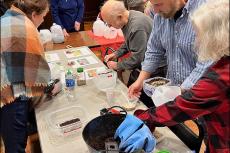Time is short to send feedback to Suffolk County as to where best to position lease sites for its Aquaculture Lease Program in Peconic Bay and Gardiner’s Bay, several residents told the East Hampton Town Trustees on Monday. They urged the trustees to consider the rights of individual community members who are neither oyster farmers nor commercial fishermen.
A vigorous debate among the trustees on Nov. 15 ended with John Aldred, who represents them in the county’s current 10-year review of the program, uncertain as to what to recommend. On Monday, residents protested that they had not foreseen one outcome of the program: acres of floating cages, which, they said, not only pose a serious navigational hazard but interfere with recreational use of the waterways.
The program, in which parcels are leased for private commercial shellfish cultivation, was adopted in 2009; implementation began in 2010. A review is required to determine if and how it should be changed in 2020 and beyond, including an overall evaluation of it to date.
Additional comment as to where leases should be sited must be submitted to the county within 30 days of Nov. 20, Curt Schade told the trustees, “a little more than three weeks from today.” The map created 10 years ago, he said, “resulted in the location of 22 lease sites in the Town of East Hampton based exclusively on the input of the baymen, and as a result of this partial and incomplete input, these sites were located in areas with very heavy boat traffic and longstanding significant recreational uses.”
The lack of input from other groups led to conflicts, he reminded the trustees. The Devon Yacht Club sued the county’s aquaculture lease board, as well as its Planning Department, the town, and other entities and leaseholders, citing navigational hazards created by two lease sites. That lawsuit has been settled.
Leaving out the other groups, Mr. Schade suggested, may have been because everyone thought that leaseholders would sink their gear to the bay bottom, “as opposed to surface gear sites which would give over hundreds of acres of public-service waters to for-profit businesses.”
It is understood that oysters at the surface will grow faster due to the concentration of nutrients higher in the water column.
Mr. Schade noted that the county plan states that oyster cages are typically “stacked together and placed on the bay bottom; and are connected to a line and marker float to enable retrieval,” periodically pulled to the surface and the oysters checked, sorted, and removed if of harvestable size, and “then cleaned of marine growth and fouling before they are returned to the bottom.” Clearly, he said, “that was the intent at the time.” He respects farmers’ desire to use floating gear, he said, but “locations that don’t conflict with other uses or create navigational hazards should be found.”
Conflicts between groups is “an eminently fixable problem,” he said, “if we limit floating gear to sites with less navigational conflict and mandate gear on the bottom as originally intended in busier, more heavily used areas.”
He complained that Mr. Aldred “did not represent our input last week” when Mr. Aldred and Barley Dunne, director of the town’s shellfish hatchery, met with county officials. “Since John’s been appointed to speak for the trustees, his omission last week likely reflects that he needs to know what the trustees are thinking on this matter,” Mr. Schade concluded.
Mr. Aldred and Francis Bock, the trustees’ clerk, had suggested at the Nov. 15 meeting that some lease sites be moved to Northwest Harbor. Rick Drew, a trustee, emphatically disagreed, criticizing the program and stating that such a move would only compound the problematic situation.
Peter Mendelman, an owner of several marinas and a vessel repair business on Three Mile Harbor, showed still photographs and a video to illustrate how hard it is to see a floating cage from a moving vessel. A row of floating oyster cages is “equivalent to rocks” that would injure a vessel’s passengers if struck, he said. “People are going to fly forward into the windshield, teeth are going to get broken. We’ve seen it happen.”
The aquaculture lease program “could grow into something positive for the community,” Mr. Mendelman said. “But the floating surface gear is a real problem.” He has talked to county officials, and “it became very clear to me that the enabling legislation at Suffolk County has no ability for the Suffolk County Planning Department to dictate where in the water column it lays. What’s needed as part of this 10-year review process is for the Suffolk County legislators to actually enable the planners and regulators to dictate where in the column it has to be.” Without that ability, “it should be banned, because you have to be able to control it.”
Vincent and Joan Priori of Lazy Point in Amagansett also spoke. The county deserves credit “because they’ve shown genuine interest in developing a new plan,” Ms. Priori said, and it is incumbent on the trustees and the town board “to provide an honest and accurate assessment” of the program “as it currently applies to East Hampton.” In her view, it has neither improved the local economy nor provided “a decent living for any oyster-farmer.” At the least, she said, the program should be “conducted in the right place using appropriate equipment” that “is not going to interfere with the public’s right to use the water. Gardiner’s Bay, she said, “is not the right place.”
The 10-year review advisory group met three times in 2019. Another meeting is to take place late in January 2020.




